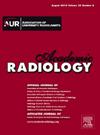Development and Validation of a Machine Learning Radiomics Model based on Multiparametric MRI for Predicting Progesterone Receptor Expression in Meningioma: A Multicenter Study
IF 3.8
2区 医学
Q1 RADIOLOGY, NUCLEAR MEDICINE & MEDICAL IMAGING
引用次数: 0
Abstract
Rationale and Objectives
This study aimed to develop and validate a machine learning-based prediction model for preoperatively predicting progesterone receptor (PR) expression in meningioma patients using multiparametric magnetic resonance imaging (MRI).
Materials and Methods
The study retrospectively enrolled 739 patients with pathologically confirmed meningioma from three medical centers, dividing them into four cohorts: training (n = 294), internal test (n = 126), external test 1 (n = 217), and external test 2 (n = 102). Radiomics characteristics were derived from T2-weighted and contrast-enhanced T1-weighted MRI images, followed by feature selection. A machine learning-based combined model was developed by incorporating radiomics scores (rad-scores) from the optimal radiomics model along with clinical predictors. The Shapley additive explanation (SHAP) method was employed to visually represent the process of making predictions. The prognostic value of the model was evaluated using Kaplan-Meier analysis.
Results
Among the 739 patients, 299 (40.5%) had negative PR expression confirmed by pathology. Twelve radiomics features derived from multiparametric MRI were selected to build the radiomics model. Tumor location and enhancement pattern were identified as key clinical predictors and were combined with rad-scores to create a combined model utilizing the extreme gradient boosting (XGBoost) algorithm. The combined model demonstrated strong accuracy and robustness, with area under the curve values of 0.907, 0.827, 0.846, and 0.807 across training, internal test, external test 1, and external test 2 cohorts, respectively. The recurrence-free survival analysis indicated that the combined model was able to effectively categorize patients based on recurrence outcomes.
Conclusion
The XGBoost combined model, utilizing multiparametric MRI, shows promise for predicting PR expression in meningioma patients.
基于多参数MRI预测脑膜瘤中孕激素受体表达的机器学习放射组学模型的开发和验证:一项多中心研究。
基本原理和目的:本研究旨在开发和验证一种基于机器学习的预测模型,用于术前使用多参数磁共振成像(MRI)预测脑膜瘤患者的孕激素受体(PR)表达。材料和方法:本研究回顾性地纳入了来自三个医学中心的739例病理证实的脑膜瘤患者,将其分为四个队列:训练组(n = 294)、内部试验组(n = 126)、外部试验1组(n = 217)和外部试验2组(n = 102)。放射组学特征来源于t2加权和对比增强的t1加权MRI图像,然后进行特征选择。通过结合最佳放射组学模型中的放射组学评分(rad-scores)以及临床预测因子,开发了基于机器学习的组合模型。采用Shapley加性解释(SHAP)方法直观地表示预测过程。采用Kaplan-Meier分析评价模型的预后价值。结果:739例患者中,病理证实PR阴性表达299例(40.5%)。选取从多参数MRI得到的12个放射组学特征构建放射组学模型。肿瘤位置和增强模式被确定为关键的临床预测指标,并与rad评分相结合,利用极限梯度增强(XGBoost)算法创建一个联合模型。联合模型具有较强的准确性和稳健性,训练、内部测试、外部测试1和外部测试2队列的曲线下面积分别为0.907、0.827、0.846和0.807。无复发生存分析表明,联合模型能够根据复发结果有效地对患者进行分类。结论:XGBoost联合模型利用多参数MRI预测脑膜瘤患者PR表达。
本文章由计算机程序翻译,如有差异,请以英文原文为准。
求助全文
约1分钟内获得全文
求助全文
来源期刊

Academic Radiology
医学-核医学
CiteScore
7.60
自引率
10.40%
发文量
432
审稿时长
18 days
期刊介绍:
Academic Radiology publishes original reports of clinical and laboratory investigations in diagnostic imaging, the diagnostic use of radioactive isotopes, computed tomography, positron emission tomography, magnetic resonance imaging, ultrasound, digital subtraction angiography, image-guided interventions and related techniques. It also includes brief technical reports describing original observations, techniques, and instrumental developments; state-of-the-art reports on clinical issues, new technology and other topics of current medical importance; meta-analyses; scientific studies and opinions on radiologic education; and letters to the Editor.
 求助内容:
求助内容: 应助结果提醒方式:
应助结果提醒方式:


